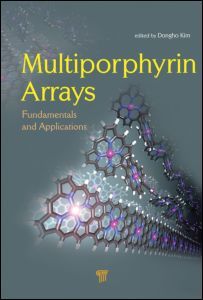Multiporphyrin Arrays Fundamentals and Applications
Coordonnateur : Kim Dongho

This book provides a comprehensive review of the fundamentals and applications of multiporphyrin arrays ranging from basic spectroscopic features to a wide range of promising applications such as molecular wires, switches, sensors, artificial photosynthetic devices, and dye-sensitized solar cells based on a variety of multiporphyrin architectures using covalent and/or noncovalent molecular assemblies. Particularly, it focuses on energy and electron transfer processes occurring in multiporphyrin arrays in various environments such as single-molecule level, composite materials, LB films, and solid surface to provide better understanding of photofunctional molecular architectures.
Single-Molecule Photophysical Properties of Various Directly linked Porphyrin Arrays,. Electron Transfer Through Butadiyne-Linked Porphyrin-Based Molecular Wires. Recent Applications of MCD Spectroscopy to Porphyrinoids. Phthalocyanine–Porphyrin Heteroarrays: A Perfect Marriage Between Two Unique Macrocycles. Primary Photoevents in Self-Assembled Complexes: Multiporphyrin Arrays and "Semiconductor CdSe/ZnS Nanocrystal-Porphyrin" Composites. Structural and Functional Mimics of Light-Harvesting Systems in Bacterial Photosynthesis. Light-Harvesting, Excitation Energy/Electron Transfer and Photo-Regulation in Artificial Photosynthetic Systems. Artificial Photosynthetic Antenna-Reaction Center Mimics. Application of Multiporphyrin Arrays to Solar Energy Conversion. Self-Assembled Composite Materials of Porphyrins for Optoelectronics. Vectorial Photoinduced Charge Transfer in Langmuir–Blodgett Films of Porphyrin-Based Donor–Acceptor Systems. Supramolecular Energy and Electron Transfer Processes and Their Switching. Porphyrin Nanoclusters for Sensoring Chemical and Physical Stimuli. Energy and Electron Transfer Processes in Porphyrin Dendrimers. Push-Pull Porphyrins for Efficient Dye-Sensitized Solar Cells.
Dongho Kim received his BS in 1980 from Seoul National University, Seal, South Korea, and Ph.D. in 1984 from Washington University, Washington, DC. After postdoctoral research at Princeton University, New Jersey, he joined the Korea Research Institute of Standards and Science, Daejeon, South Korea, in 1986. In 2000, he moved to Yonsei University, Seal, South Korea as a professor of chemistry. He received the Scientist of the Month Award (1999), the Sigma-Aldrich Award (2005), the Korea Science Award in Chemistry (2006), and the Star Faculty Award (2006) and was selected as the Underwood Professor at Yonsei University (2007). Since 2002, he has been a fellow of The Korea Academy of Science and Technology. Currently, he is leading the Center for Smart Nano-Conjugates through the World Class University Program. His research activity is focused on the experimental investigation of pi-conjugated molecular systems such as porphyrin, pyrene, perylenebisimide, and thiophene and their assemblies with particular interest in excitation dynamics both in ensemble and at single-molecule level. He has coauthored more than 350 articles and about 15 reviews in journals and books. He has served as an editorial board member for Bulletin of the Korean Chemical Society, Journal of Porphyrins and Phthalocyanines, and Journal of Physical Chemistry.
Date de parution : 01-2012
15.2x22.9 cm
Thèmes de Multiporphyrin Arrays :
Mots-clés :
Pet; Multiporphyrin Arrays; Single-Molecule Photophysical Properties of Various Directly linked Porphyrin Arrays; Soret Band; Phthalocyanine–Porphyrin Heteroarrays: A Perfect Marriage Between Two Unique Macrocycles; Zinc Porphyrin; Structural and Functional Mimics of Light-Harvesting Systems in Bacterial Photosynthesis; Porphyrin Units; Self-Assembled Composite Materials of Porphyrins for Optoelectronics; Maximum IPCE; Push-Pull Porphyrins for Efficient Dye-Sensitized Solar Cells; Porphyrin Dimer; Charge Recombination; Free Base Porphyrin; Excitation Energy Transfer; UV Visible Absorption Spectrum; MCD Spectrum; Exciton Coupling; Excited Singlet State; Exciton Exciton Annihilation; Electron Transfer; Charge Separation; TD DFT Calculation; S1 State; Porphyrin Arrays; STM Image; Pc Macrocycle; LUMO Value; Band Iii; Pet Process



